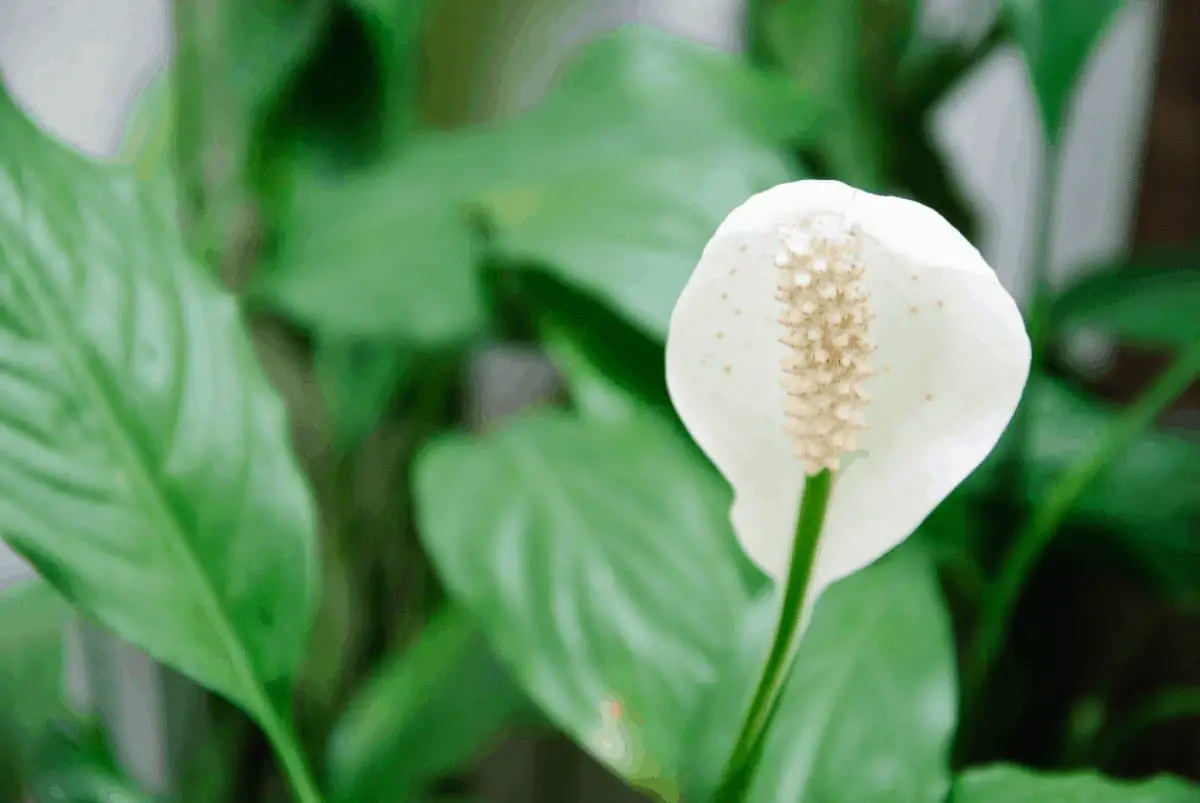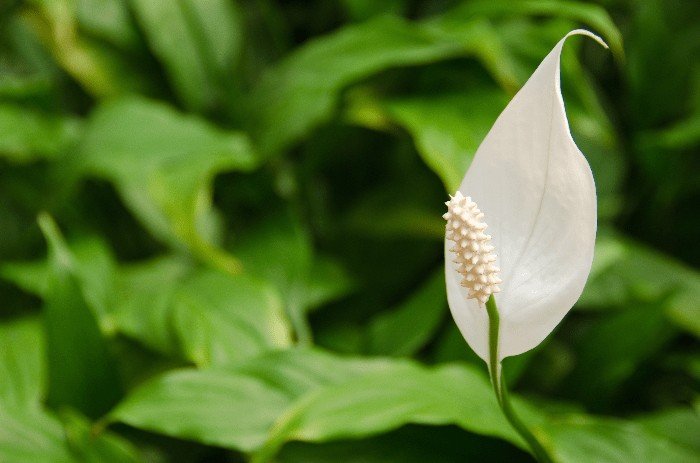Last Updated on April 25, 2022 by Fabiola L.
How to prune a peace lily? Peace lilies are beautiful flowers often used as indoor decorations. They are adaptable and low-maintenance, meaning gardeners who possess all levels of experience can manage to keep one alive for a long time. They make great floor plants since they can sometimes grow up to 3 ft. tall, and is surprisingly amazing at cleaning the air breathed by individuals indoors. Even NASA recognized the flower’s greatness, putting it on one of their top ten lists.
However, people can’t grow peace lily without a little knowledge. Besides needing to understand just how often to water and fertilize the plant, it’s also necessary to know whether or not the lily needs to be pruned on a regular basis. Pruning is often done to eliminate dead growth and can be essential for future health and wellness.
But does the peace lily need to be pruned? In short, yes. But how?
How To Prune A Peace Lily: The Proper Way to Prune A Peace Lily
Peace lilies actually require little to no pruning to stay healthy and strong. They do not produce many blooms, and the bud that is produced tends to have one bract or flowerlike structure that looks like a white petal. Since there aren’t many blooms, you don’t need to trim a bunch of deceased buds at the end of the growing season.
Individuals who do want to prune should cut the bract once it has died for the season. Instead of cutting directly underneath the flower, prune lower on the stem. This ensures there is more room for new stems to grow once the right season comes again.
Besides the flower stalks, it might be necessary to prune the leaves. Normally, they should be allowed to grow luxurious and green. However, sometimes they start to fade and turn yellow, especially if there has been a water shortage or too much sunlight. When this happens, cut away the offending leaves at their base, not in the center of the leaf.
After you remove each leaf, disinfect your shears or scissors. This eliminates the possibility of spreading disease that could have caused the leaves to yellow in the first place.
Deadheading
Deadheading is a common element of pruning, including for peace lilies. This process is when individuals cut away dead flowers to make room for fresh ones. It is a crucial process for many plants, but especially annuals and perennials that will continue to flower throughout the growing season.
If you want to deadhead a peace lily, focus on cutting away the bud just underneath the bloom itself. This should be done before the first set of healthy leaves. Because the peace lily tends to only produce one bract, consider cutting down all the way to the bottom of the stem before it reaches the leaves. This will facilitate future growth.
How To Prune A Peace Lily: Avoid Leaving Trimmings
Whether or not a peace lily is kept indoors will depend on the individual, but it’s important not to leave any trimmings behind. According to the American Society for the Prevention of Cruelty to Animals (ASPCA), peace lilies are toxic to cats and dogs. Leaves, petals, stems, and other elements should not be left behind after trimming, as they might be consumed by pets or stray animals looking for a snack.
If you do choose to keep and prune a peace lily indoors, try to keep it out of reach of the household animals. Ensuring it doesn’t get chewed on can facilitate growth just as much as pruning!
What to Use
Although many novice gardeners try to use regular kitchen scissors, this is a bad idea for pruning peace lilies. Instead of using these scissors, which are full of bacteria and often don’t have sharp edges, consider using professional pruning shears instead.
Hand pruners are the best type to use because they are small and scissor-like. Using a larger set would be overkill since peace lilies do not grow very large. To find a good pair of hand pruners, consider going to a dedicated gardening store. They will have a wide variety.
If you need to sanitize the shears after use, use a basic alcohol solution. It will kill any bacteria and leave the blades ready for future use. Allow the solution and shears to dry before attempting to prune again. Alcohol can kill flowers and other plants.
How to Care for the Lily
Sometimes people resort to pruning if their plants seem unhealthy. When it comes to a peace lily, which is quite simple, the most common cause of ill health is more likely to be some form of environmental deficiency or mismanagement than unwanted growth. If you want to prune your lily, consider modifying the environment first and making sure all of the plant’s needs are being met before you take out the shears.
High humidity is another necessity, and fertilizer should be used sparingly. If you do want to fertilize, consider using a mild house blend every six weeks in small amounts. Avoid the temptation to supply too many nutrients. At the same time, avoid direct afternoon sunlight and try to keep the plant in more natural and moderate amounts of light.
Make these changes and give the plant a week. If it doesn’t seem to be recovering, then you can go ahead and start to prune. Keep the pruning to a minimum at first; don’t try to cut away too much straight away.
You can buy you Peace Lily Plant here.
How To Prune A Peace Lily: Conclusion
Caring for a peace lily is a great place for beginner gardeners, but can also be an excellent way for advanced individuals to test their skills and beautify their homes. Whether or not you prune is ultimately your decision, but there are numerous benefits to doing so. While it isn’t necessary, regular pruning ensures the flower remains healthy and can stop the spread of illness or bacteria from one infected leaf to another.
FAQs
Is it OK to cut back a peace lily?
It is generally not a good idea to cut back a peace lily. The best solution is to repot your plant to improve drainage and raise the soil level if needed. Repotting your plant will also help it produce more blooms.
The peace lily is a tropical plant that needs a lot of moisture and bright, indirect sunlight. Cut back the stem of the plant by two-thirds so that it does not have to work as hard to grow, but do this sparingly because you can damage the roots if you cut off too much at once.
Can I cut the brown tips off my peace lily?
Peace lily is an easy to grow plant that can be found at most garden centers. However, its leaves may develop brown tips, which is not a sign of disease or dehydration. It's just natural for the plant to shed its old leaves for new ones to grow. So if you want to remove the brown tips on your peace lily, you can safely do so.
Some people prefer to cut off the dead parts of their plants because they think it will help them grow better. But this isn't true; plants naturally shed their old leaves and don't need help from humans. Plus, cutting off too many leaves can leave the plant vulnerable to diseases like root rot and soil erosion because it lacks protection from the elements."
How long do peace lilies live?
Peace lilies are a beautiful flower that can be grown inside of the home. They bloom for about 18 months and then they need to be transplanted to a larger pot or outside of the home.
Peace lilies need to be planted in well-draining soil. They should be planted in full sun exposure, but they can take partial shade as well. Potted peace lilies thrive on regular watering, but these plants can also be watered by placing them near a water source that recirculates the water through the potting soil.
Why do the flowers on peace lily turn brown?
One of the reasons for the browning flowers is because the flower’s stem is not long enough to support them all fully, so they start to fall over. This causes some parts of the flowers to dry out and wilt, leading to a slow decay process.
How long do peace lilies live?
All the peace lilies in your garden will live more than 3 years. Some of them may even survive up to 10 years in ideal conditions, while some others may only last for 2-3 months.
The life of a peace lily depends on many factors like location, temperature, light conditions and soil.
Does a peace lily like to be root bound?
The peace lily is an ornamental plant that is used as a symbol of peace. It grows from a rhizome, which is usually covered with a large number of roots from the ground.
A peace lily likes to be root bound. They like to be in soil with a small amount of nutrients and good drainage, but they dislike being planted in wet or waterlogged soil.
Read more about 11 Amazing Plants That Look Like Peace Lily
Tony Manhart is a passionate gardener who has been tending to gardens for over 20 years. He takes pride in creating beautiful outdoor spaces with plants, trees, and shrubs that can thrive in any environment. He loves to share his knowledge with others and has taught classes on gardening basics and advanced techniques. He is committed to sustainability, using natural and organic methods to create and maintain gardens. He also works with local organizations to create green spaces for communities. When he’s not gardening, Tony enjoys hiking, reading, and spending time with his family.




